
Concept explainers
(a)
Interpretation:
The product formed in the given reaction is to be stated.
Concept introduction:
Oxime belongs to the family of imines. The formula of oxime is
Answer to Problem 19.48AP
The product formed in the given reaction is cyclohexanone oxime in the presence of hydroxylamine and pyridine. The reaction is shown below.

Explanation of Solution
Cyclohexanone reacts with hydroxylamine to form the derivative of the oxime of the carbonyl compound. The nucleophilic addition takes place in the given reaction. The hydroxylamine is used as a nucleophile. The corresponding

Figure 1
The product formed in the given reaction is shown in Figure 1.
(b)
Interpretation:
The product formed in the given reaction is to be stated.
Concept introduction:
The reaction between
Answer to Problem 19.48AP
The product obtained in the given reaction is shown below.
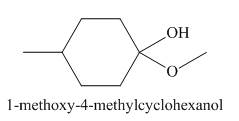
Explanation of Solution
In the given reaction,
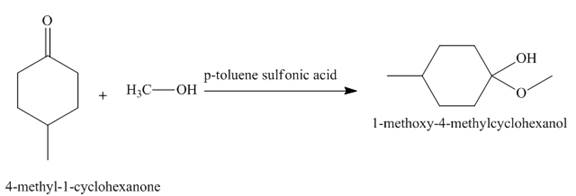
Figure 2
The treatment of
(c)
Interpretation:
The product formed in the given reaction is to be stated.
Concept introduction:
Ketones react with
Answer to Problem 19.48AP
The product formed in the given reaction is a hemiacetal as shown below.
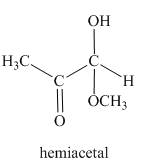
Explanation of Solution
In the third reaction, the methylglyoxal reacts with
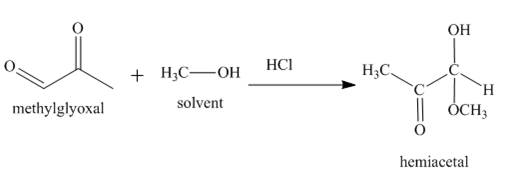
Figure 3
The reaction between methylglyoxal and
(d)
Interpretation:
The product formed in the given reaction is to be stated.
Concept introduction:
The cyclic ethers are ring compounds which contain nitrogen, sulfur and oxygen groups within the ring. The easy method for synthesis of cyclic ether is Williamson synthesis.
Answer to Problem 19.48AP
The product formed when the
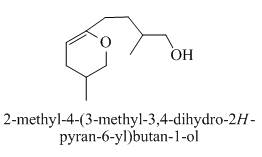
Explanation of Solution
The compound
When acid is treating with

Figure 4
The product formed on the treatment of
(e)
Interpretation:
The product formed in the given reaction is to be stated.
Concept introduction:
Grignard reagents are
Answer to Problem 19.48AP
The compound
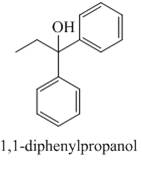
Explanation of Solution
The compound
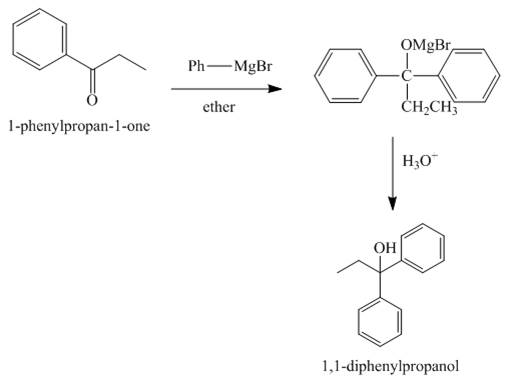
Figure 5
The reaction between
(f)
Interpretation:
The product formed in the given reaction is to be stated.
Concept introduction:
The conversion of an aldehydic or ketonic group to alkene with the help of Wittig reagent is known as Wittig reaction.. The chemical name of Wittig reagent is triphenyl phosphonium ylide. The Wittig reagent gives good yields of alkene even when other
Answer to Problem 19.48AP
The product formed in the given reaction is
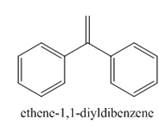
Explanation of Solution
The carbonyl compounds react with Wittig reagent. The product formed is alkenes. In this Wittig reaction, most of the ketone reacts with triphenyl phosphonium ylide to generate an alkene and triphenylphosphine oxide as shown below.
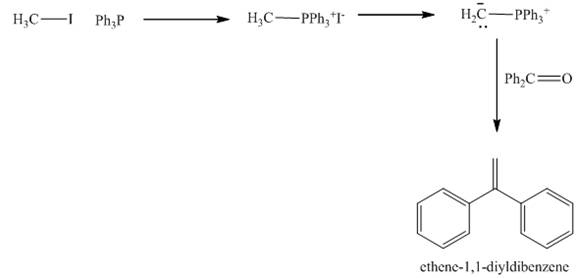
Figure 6
The treatment of haloalkane with triphenylphosphine gives the product
(g)
Interpretation:
The product formed in the given reaction is to be stated.
Concept introduction:
The Wittig reaction is the chemical reaction involves a change in an aldehyde or ketone converted into an alkene. The chemical name of Wittig reagent is triphenyl phosphonium ylide. The Wittig reagent gives good yields of alkene even when other functional groups are present on the aldehydes or ketone. However, as the steric hindrance of the aldehydes or ketone increases, the yield of alkene decreases.
Answer to Problem 19.48AP
The product formed in the given reaction is shown below.
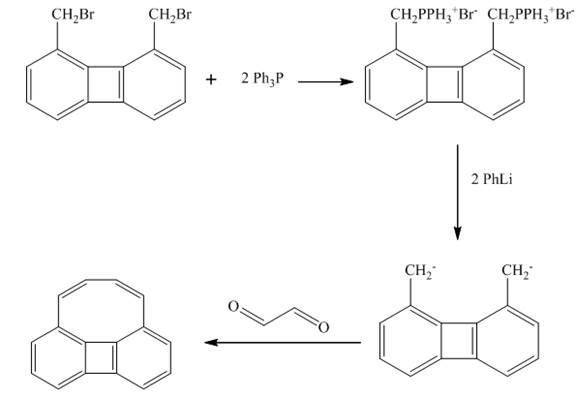
Explanation of Solution
The reaction is Wittig reaction. The reagent used is is triphenyl phosphonium ylide.
In the first step, the treatment of triphenyl phosphonium ylide reacts with

Figure 7
The given reaction is shown in Figure 7 in the presence of Wittig reagent.
Want to see more full solutions like this?
Chapter 19 Solutions
EBK ORGANIC CHEMISTRY
- Write the systematic name of each organic molecule: structure HO-C-CH2-CH3 O -OH CH3-CH2-CH2-CH2-CH2-C-OH CH3 CH3-CH-CH2-C-OH Explanation Check S namearrow_forwardtheres 2 productsarrow_forwardDraw the major product of this solvolysis reaction. Ignore any inorganic byproducts. + CH3CH2OH Drawing Q Atoms, Bonds and Rings OCH2CH3 || OEt Charges OH 00-> | Undo Reset | Br Remove Done Drag To Pan +arrow_forward
- Draw the major product of this SN1 reaction. Ignore any inorganic byproducts. CH3CO2Na CH3CO2H Drawing + Br Q Atoms, Bonds and Rings OAC Charges OH ОАс Na ဂ Br Undo Reset Remove Done Drag To Pan +arrow_forwardOrganic Functional Groups entifying positions labeled with Greek letters in acids and derivatives 1/5 ssible, replace an H atom on the a carbon of the molecule in the drawing area with a ce an H atom on the ẞ carbon with a hydroxyl group substituent. ne of the substituents can't be added for any reason, just don't add it. If neither substi er the drawing area. O H OH Oneither substituent can be added. Check D 1 Accessibility ado na witharrow_forwardDifferentiate between electrophilic and nucleophilic groups. Give examples.arrow_forward
- An aldehyde/ketone plus an alcohol gives a hemiacetal, and an excess of alcohol gives an acetal. The reaction is an equilibrium; in aldehydes, it's shifted to the right and in ketones, to the left. Explain.arrow_forwardDraw a Haworth projection or a common cyclic form of this monosaccharide: H- -OH H- OH H- -OH CH₂OHarrow_forwardAnswer the question in the first photoarrow_forward
- Ggggffg2258555426855 please don't use AI Calculate the positions at which the probability of a particle in a one-dimensional box is maximum if the particle is in the fifth energy level and in the eighth energy level.arrow_forwardExplain the concepts of hemiacetal and acetal.arrow_forwardBriefly describe a nucleophilic addition.arrow_forward
 ChemistryChemistryISBN:9781305957404Author:Steven S. Zumdahl, Susan A. Zumdahl, Donald J. DeCostePublisher:Cengage Learning
ChemistryChemistryISBN:9781305957404Author:Steven S. Zumdahl, Susan A. Zumdahl, Donald J. DeCostePublisher:Cengage Learning ChemistryChemistryISBN:9781259911156Author:Raymond Chang Dr., Jason Overby ProfessorPublisher:McGraw-Hill Education
ChemistryChemistryISBN:9781259911156Author:Raymond Chang Dr., Jason Overby ProfessorPublisher:McGraw-Hill Education Principles of Instrumental AnalysisChemistryISBN:9781305577213Author:Douglas A. Skoog, F. James Holler, Stanley R. CrouchPublisher:Cengage Learning
Principles of Instrumental AnalysisChemistryISBN:9781305577213Author:Douglas A. Skoog, F. James Holler, Stanley R. CrouchPublisher:Cengage Learning Organic ChemistryChemistryISBN:9780078021558Author:Janice Gorzynski Smith Dr.Publisher:McGraw-Hill Education
Organic ChemistryChemistryISBN:9780078021558Author:Janice Gorzynski Smith Dr.Publisher:McGraw-Hill Education Chemistry: Principles and ReactionsChemistryISBN:9781305079373Author:William L. Masterton, Cecile N. HurleyPublisher:Cengage Learning
Chemistry: Principles and ReactionsChemistryISBN:9781305079373Author:William L. Masterton, Cecile N. HurleyPublisher:Cengage Learning Elementary Principles of Chemical Processes, Bind...ChemistryISBN:9781118431221Author:Richard M. Felder, Ronald W. Rousseau, Lisa G. BullardPublisher:WILEY
Elementary Principles of Chemical Processes, Bind...ChemistryISBN:9781118431221Author:Richard M. Felder, Ronald W. Rousseau, Lisa G. BullardPublisher:WILEY





